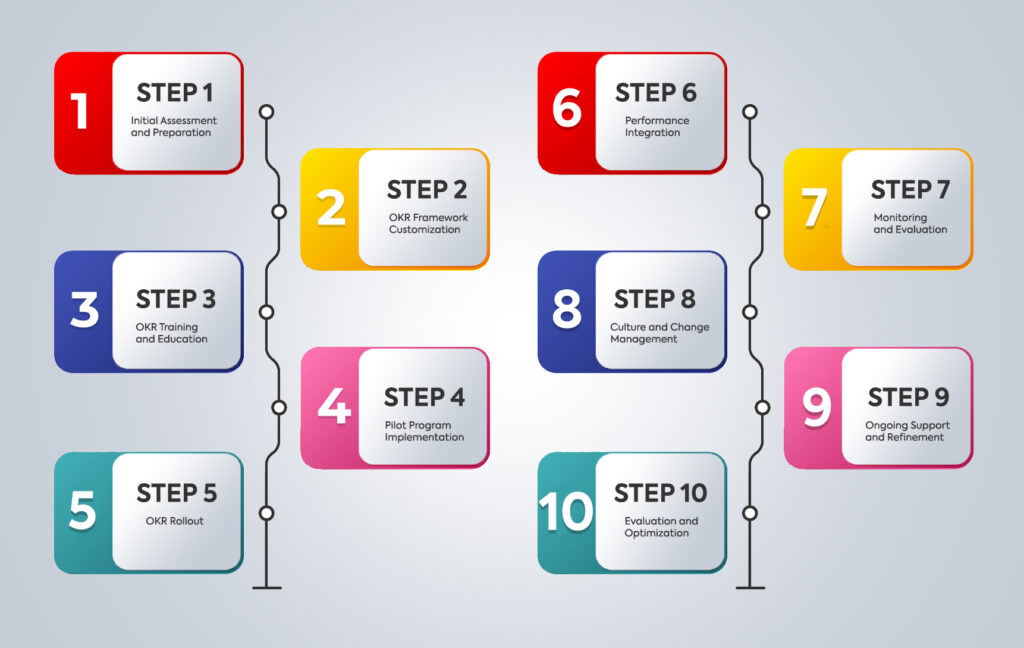Step by step plan for rolling out OKRs
Implementing the OKR (Objectives and Key Results) framework in an organization requires a well-structured plan to ensure successful adoption and integration into an organization and its culture.
Here's a detailed step-by-step plan to implement OKRs in a technology organization:

Understand the organization's current state and readiness for OKR adoption.
Needs Assessment:
- Conduct interviews and surveys with key stakeholders to understand their goals, challenges, and expectations.
- Assess the organization's existing goal-setting and performance management processes.
Leadership Engagement:
- Meet with top leadership to gain their commitment and support for OKR implementation.
- Educate leaders about the benefits of OKRs and how they align with the organization's strategic objectives.
Tailor the OKR framework to meet the specific needs and culture of the technology organization.
Customization:
- Customize the OKR framework, templates, and guidelines to align with the organization's terminology and processes.
- Define the frequency of OKR cycles (e.g., quarterly, annually) based on the organization's preferences.
Equip employees with the knowledge and skills needed to create and manage effective OKRs.
OKR Workshops:
- Organize OKR workshops and training sessions for employees at all levels.
- Provide hands-on guidance on setting, tracking, and managing OKRs.
Resource Development:
- Create OKR documentation, guides, and resources for easy reference.
- Establish an internal OKR knowledge base or portal for employees to access information.
Test the OKR framework in a controlled environment before full-scale rollout.
Select Pilot Teams:
- Choose one or more technology teams or departments to participate in the pilot program.
- Ensure participants understand the objectives and expectations of the pilot.
Pilot Execution:
- Guide pilot teams through the process of setting their OKRs for a defined period (e.g., a quarter).
- Monitor progress and provide support as needed during the pilot.
Implement OKRs organization-wide with a phased approach.
Phase 1-Departmental Rollout:
- Begin OKR implementation in select departments or teams where alignment with strategic goals is critical.
- Conduct training and provide support to these early adopters.
Phase 2-Full Rollout:
- Expand OKRs to all departments and teams across the organization.
- Cascade OKRs from top leadership to individual contributors, ensuring alignment at all levels.
Integrate OKRs with the organization's performance management and review processes.
Performance Reviews:
- Align OKRs with employee performance reviews, ensuring that OKRs contribute to performance evaluations and goal-setting discussions.
Feedback and Coaching:
- Train managers to provide feedback and coaching related to OKRs during performance discussions.
- Encourage ongoing dialogue between managers and employees.
Continuously monitor OKR progress and evaluate the impact of the framework.
OKR Tracking:
- Implement OKR tracking tools or software to monitor progress, track key results, and visualize performance.
KPI Measurement:
- Define key performance indicators (KPIs) to assess the effectiveness of OKRs in driving results and alignment.
Foster a culture of goal alignment, accountability, and continuous improvement.
Change Management:
- Implement change management activities to address resistance and facilitate a smooth transition.
Celebrate Success:
- Recognize and celebrate achievements of teams and individuals who successfully meet their OKRs.
Ensure the sustainability of the OKR framework and continuously improve its implementation.
Sustainability:
- Embed OKRs into the organization's culture and make them an ongoing practice.
- Provide ongoing support, resources, and coaching to teams and employees.
Feedback Loop:
- Establish a feedback loop to gather input and insights from employees and leaders for continuous improvement.
Evaluate the impact of OKRs and optimize the implementation process.
Assessment:
- Conduct regular assessments of OKR adoption and effectiveness.
- Use data and feedback to identify areas for optimization.
Adjustment and Iteration:
- Make adjustments to the OKR framework, processes, and training based on lessons learned and evolving organizational needs.
- By following this comprehensive plan, organizations can successfully adopt and integrate the OKR framework, enabling the organization to achieve alignment, accountability, and improved performance.